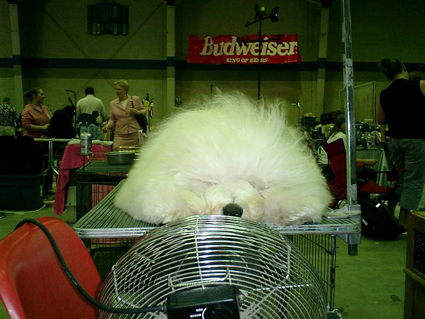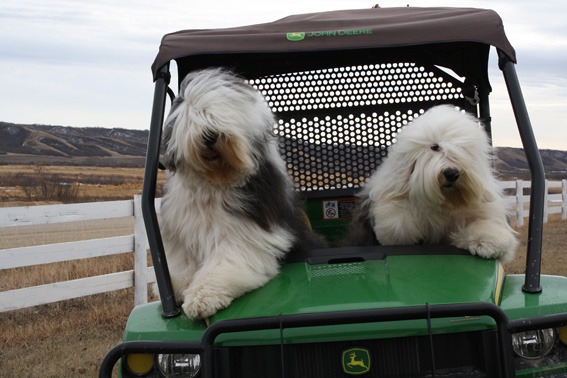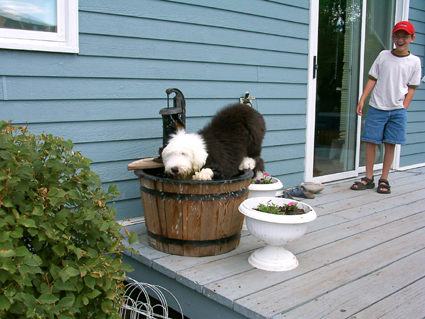ABOUT Old English Sheepdogs
The Old English Sheepdog (OES), or Bobtail, originated over 200 years ago in England’s West Country. It is thought that they descended from a variety of European herding breeds, and their main function was to herd and drive sheep to market. If the OES was a working dog, his tail was docked, therefore making him exempt from the English dog tax. This is why they have the nickname of Bobtail.
The breed standard or “blueprint” that was drawn up in the late 19th century England (1885), outlined the conformation and temperament traits considered desirable for the breed. This standard remains basically the same today, and was the one adopted in Canada when OES were first imported to this country. See the current OES Breed Standard for the full description.

Much to the surprise of prospective pet owners, the OES does not “shed” in the same manner that many other popular breeds do. They also elicit far fewer allergic reactions than most breeds. If the coat is kept long, regular brushing is required to keep it healthy and matt-free. Most people who have a sheepdog as a pet keep the coat short and easy to care for, with regular trips to a groomer for trimming and tidying. Pet owners can easily learn to groom their own sheepdog with the guidance of a breeder or professional groomer. All it takes is time – and lots of it! If trained at an early age, most sheepdogs find grooming to be a pleasurable experience and look forward to their turn “on the table”. It is a myth that if you cut the “shaggy bangs” exposing the eyes, the Old English will go blind! This is not true - the Old English Sheepdog likes to see what is going on just as much as we do. For this reason, and for the safety of the dog, most owners will fasten the top knot with an elastic or barrett.
The lifespan of an Old English Sheepdog averages between 10 and 12 years - certainly many have lived longer. They remain fun loving puppies in attitude throughout their lives. There are no aliments which are unique to the OES. The breed faces the same health concerns which afflict all large breeds. Hip dysplasia, thyroid disease and eye problems are the primary health concerns. Occurring far less frequently, are cerebella ataxia, gastric torsion and deafness.
When looking to purchase a puppy, you should ask AND RECEIVE a certificate proving that the parents of your puppy and his ancestors are free of hip dysplasia and eye problems. It is not good enough that the test was done – the result must be proven! All reputable breeders will be happy to provide this information. Run quickly from those who will not!
The Old English Sheepdog has many wonderful traits: amiable, gentle, jolly, even-tempered, adaptable, friendly, faithful, protective, alert and intelligent. In every respect they are a superb companion dog. The OES is wonderful with children, although perhaps a bit rambunctious during puppyhood. They never stray far from their owner or home. Sheepdogs have a wonderful sense of humour and are the clowns of the dog world. Both males and females are equally affectionate.
Sheepdogs are easily motivated by praise, and their behaviour can be reinforced by providing interesting challenges. They love Agility, Scent Hurdles, Herding Trials, Open and Utility Work - but quickly become bored with the precision work of heeling. They are enthusiastic to learn new activities, and enjoy nothing better than to spend time outside with their owners. Once taught their place in the family structure and given adequate guidance, the OES becomes a valued, affectionate and self-regulating family member. Their temperament is predictable and reliable.

